Original Author: Xuan Rui
Source: AC Capital Research
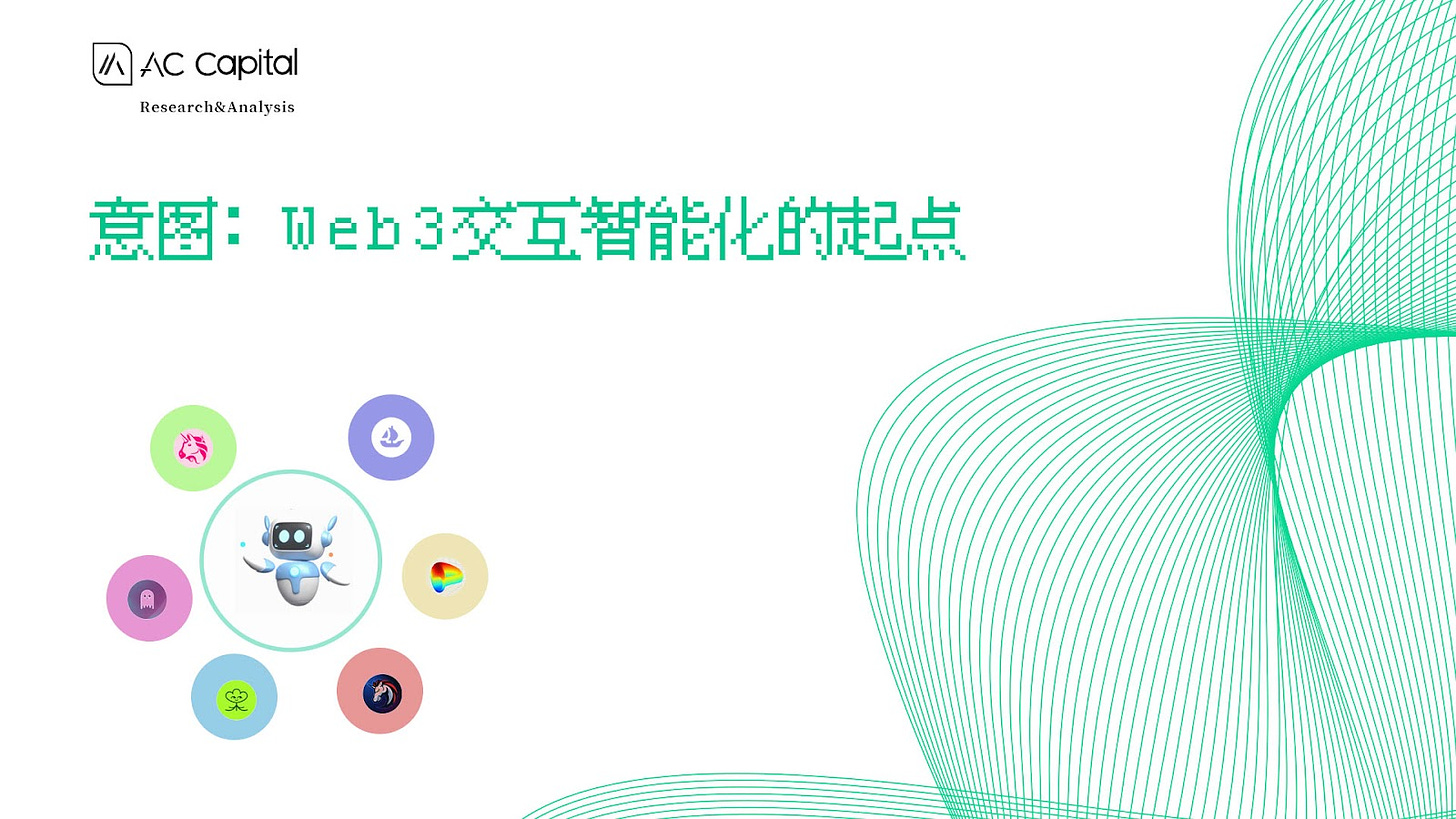
This article will combine Anoma and TG Bot to open the understanding of intent, and trace the paradigm shift behind intent, deeply understand the evolution, interaction paradigm, current state, and trends of intent concepts, and finally look forward to the challenges and future of Web3 interactive intelligence.
Summary (TL;DR)
( 1) Understanding Intent: Top-down Anoma and Bottom-up TG Bot
( 2) Deepening Intent: AI is the New UI: Complex Commands vs Simple Intent
( 3) Navigating Intent: Evolution, Interaction Paradigm, Current State, and Trends of Intent
( 4) Guiding Intent: Challenges and Prospects of Web3 Interactive Intelligence
In June, the Paradigm official website published an article "Intent-Based Architectures and Their Risks", which brought the concept of intent to the public for the first time, and the development of protocols and infrastructure related to intent has been rapid. It has become a topic that cannot be ignored in the crypto world at the ETHCC conference in July.
Intent is not a new concept, as Mindao, the founder of DForce, said: The trend in the currency circle has always been to abstract and automate all operations to the extreme. Aggregators, CEX, contract wallets, cross-chain DeFi, are all doing this work, as well as Chainlink and recent automated middleware, and recently Telegram bot.
The intention brings new changes, in the past, the focus was on product interaction, in the AGI era, the focus is on human-machine interaction, AI/LLM (Large Language Model) contains more potential for enhancing Crypo interaction.
Top-down Anoma and bottom-up Unibot
In the past half year, there have been numerous protocols, projects, and infrastructures related to intention. Here, instead of explaining the concepts in a textbook manner, I will provide two excellent examples to give you a glimpse.
Among the projects related to intention, the most shining one is Anoma Foundation, which completed its third round of financing with a total of $25 million by the end of May 2023. In the context of significant homogenization in Layer 1, Anoma Foundation, with its intent-centric architecture (Anoma Dapp full-stack architecture) and Namada (privacy Layer 1), has received a total of $57.8 million in support from investment institutions, ranking 7th in terms of financing amount for Layer 1/Layer 2 projects that have not yet been launched.
Looking back at Anoma's public speech at EthCC, the founder, Adrian Brink, mentioned the magic of Anoma: all interactions start with intention. The user's expressed intention goes through the Black-box Architecture (Anoma black-box architecture, also known as Magic Happens) for processing. The black box realizes the core transaction process based on intention interaction:
User Interaction: Users can send transparent, private, or protected intentions to Anoma's Black-box Architecture (intent gossip Layer).
Intention Collection and Matching: Anoma's Black-box Architecture's solver collects intentions, performs balanced state transitions to achieve matching with counterpart transactions.
Transaction processing: Matched transactions are submitted to the encrypted mempool, and validators send proposer-packed blocks to the execution layer, completing execution and verifying validity, ultimately updating the state root.
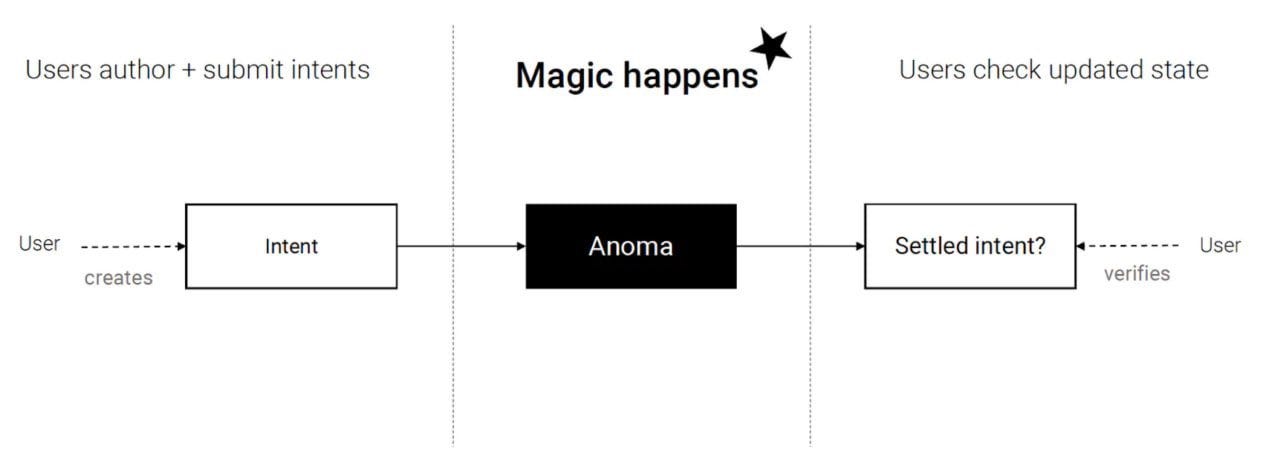
Source: https://twitter.com/Delphi_Digital/status/1696626180752056764
Behind the new interactive form, the Anoma team has insight into the pain points of the underlying blockchain protocol, and reviews the architectural limitations from the first-generation scriptable settlement of Bitcoin to the second-generation programmable settlement of Ethereum, which means that current application protocols have at least one Web2 component, unable to achieve transaction counterpart discovery and resolution. They state that the intention-centric Anoma architecture is the third-generation Dapp architecture in the evolution of blockchain protocols, allowing users to define the desired outcome states and achieve efficient and customizable private transactions at the intention level. The intention-centric Dapp architecture will usher in a new era.
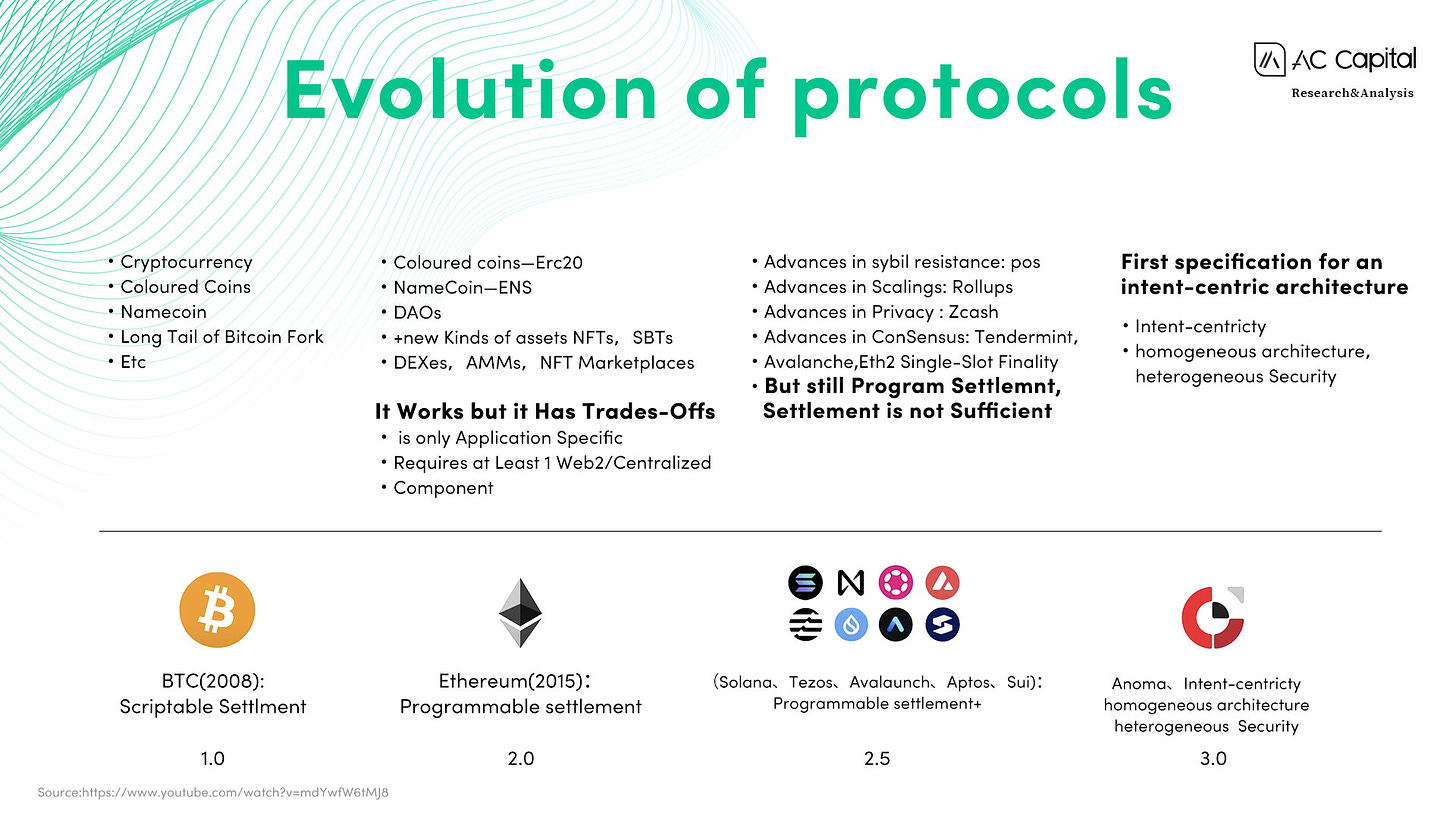
Source: https://www.youtube.com/watch?v=mdYwfW6tMJ8
With a high funding, the Anoma platform with new technological architecture is currently developed by a team of 37 interdisciplinary members from Heliax. Despite the slow progress of the Heliax development team in the past 2 years, a complete innovative ecosystem has been formed:
Anoma: An intent-centric general Dapp architecture that can be modularly deployed on L1, L1.5, and L2, and can be embedded as modular components in various EVM frameworks;
Namada: The privacy settlement Layer 1 of the Anoma ecosystem, which adopts the PoS mechanism and is used for asset-agnostic interchain privacy. It will be compatible with Ethereum and IBC chains in the future;
AnomaVM: Simplifying the development of DApp applications on Anoma using Juvix (an intent-centric programming language) and VampIR (a circuit programming language);
Typhon: Typhon consensus, an improved Tendermint based on Cosmos;
Taiga: A unified execution environment that provides composable privacy. Taiga defines three types of intents: transparent intent, shielding intent, and privacy intent.
Source: https://heliax.dev/#projects
Although many institutions such as CMCC Global, Electric Capital, and Delphi Digital have praised Anoma and expressed that the intent-centric architecture has unlimited potential, the current top-down approach of Anoma has only laid a solid technical foundation without exciting real-world applications. On the other hand, the TG Bot opens up the imagination of landing scenarios for intents using on-chain automated trading tools.
Unibot is a Telegram-based trading bot (TG Bot) that allows users to automate DEX trading through Telegram and provides features such as sniper buying, copy trading, DEX limit orders, privacy, and anti-MEV. Unibot replaces the cumbersome interaction of Uniswap with an intent-based approach, providing a convenient DeFi interaction experience. Unibot has also spawned a number of TG Bot copycats, and the total market value of the TG Bot track is approaching $200 million.
Anoma from top to bottom is innovation, TG Bot from bottom to top is transformation; Anoma starts from the intent-based underlying architecture, but the team's progress is slow; TG Bot brings users a new on-chain interaction interface, but it is not intelligent and has many security risks.
These two different paths have the same goal - to simplify user interaction and introduce a new programmable, customizable user interaction interface - the User Intent Layer, allowing users to bypass complex on-chain interactions and defining transaction states based on user intent.
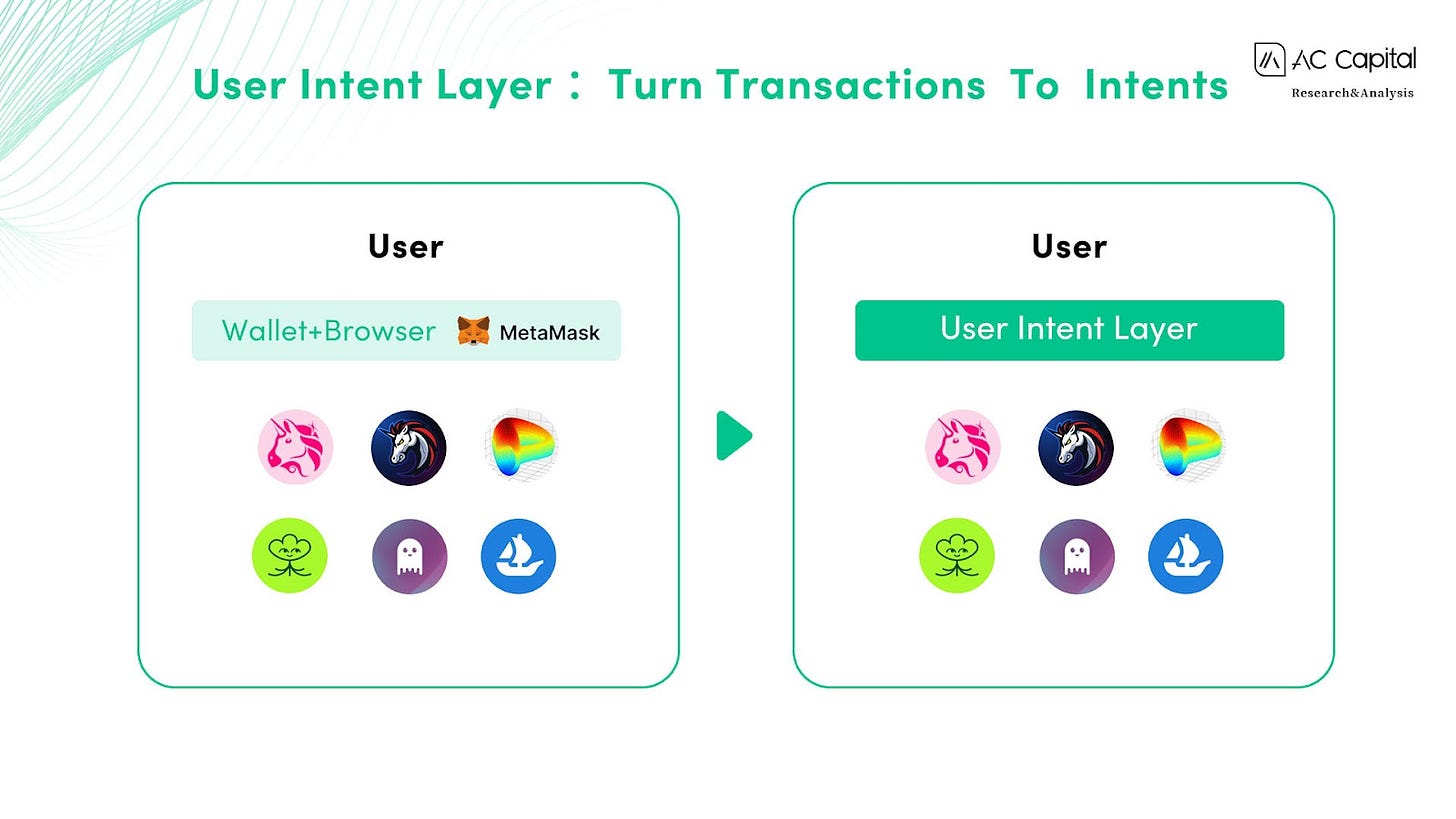
AI is the New UI: Command Interaction vs Intent Interaction
The above two use cases provide a basic understanding of intent, and now it's time to explore the fundamental change that AI brings to the most basic level of the encrypted world - the change in user interaction interface. The AI paradigm is introducing the third user interface paradigm in computer history, shifting to a new interaction mechanism where users tell the computer what they want, rather than how to do it.
Paradigm One: Batch Processing.
Paradigm Two: Command-based interaction design.
Paradigm Three: Intent-based result specification.
In history, every revolution in interaction patterns has brought forth new business models. The generative AI based on LLM has brought disruptive changes to human-computer interaction, transforming the traditional interaction with various software UIs into interaction with Chatgpt chat windows. This is an unprecedented interactive experience. LLM+crypto presents a new proposition for the encrypted world based on intent interaction. LLM also has the potential to make blockchain interaction smarter by discovering and describing user intentions.
The evolution of the concept of Intent, interaction paradigms, current status, and trends
After gaining a deep understanding of the trend of AI intelligence behind intent, we further explore the evolution of the concept of intent. Intent is not a new concept. It has been around since the Web 2.0 era, and with the rise of search engines like Google, users can input their intent, and search engines provide relevant search results to fulfill that intent.
With the rise of e-commerce platforms like Amazon and eBay, there has been a significant shift in intent-based architecture. Users can now express their intent to purchase a product, and the platform takes care of logistics. In early 2017, Gartner released a report titled "Innovation Insight: Intent-Based Networking Systems," formally proposing the concept of Intent-based Networking. The key to intent-based networking is to present users with an interface where they only need to express what they want, while the platform handles the business details.
Intent-based networking is the trend of network automation and intelligence in the Web 2.0 era. Andrew Lerner, Vice President of Research at Gartner, pointed out in 2017 that intent-based networking would be the next milestone in the field of networking.
Source: https://www.gartner.com/en/documents/3599617
The evolution from Web2 to Web3, the concept of intent in Web3 is not yet clear, but there are some consensuses:
Definition given by Paradigm: Intent is a set of declarative constraints that allow users to delegate transaction creation to specialized third-party participant networks while retaining full control over the process.
Definition given by Anoma, an intent-based underlying Dapp architecture: Intent is a message sent by the user to express custom preferences. Intent is a constraint defined by the user on what the system can do, rather than the specific execution path.
Definition given by Propellerheads, an intent-based transaction infrastructure: Intent is the part of a transaction that requires assistance from others. Intent simplifies complex transactions by outsourcing the difficult parts to third parties.
In real use cases of intent-based transactions in Web3, users create intents off-chain and outsource them to Slover (a resolver) off-chain. This simplifies the complexity of blockchain interaction by encapsulating it in the resolver, while still retaining full control over the process on-chain and reducing the barriers to on-chain interaction.
Source: https://www.brink.trade/blog/powerful-intents-part-1
Intent also brings the concept of LLM architecture - intent centric, an architecture centered around user intents. Currently, encryption protocols and infrastructure related to intent centric are embedded in the interaction layer between users and Crypto. LLM provides a better on-chain interaction experience.
LLM+Crypto introduces a new human-computer interaction paradigm. It can directly convert user intents into smart contract calls, where users only need to express their intents like using Apple's Siri. Robots/AI agents/third-party resolvers help complete complex on-chain operations. In the future, intent-based Web3 interaction intelligence has the potential to significantly reduce the complexity of user on-chain interactions.
AI is the New UI. More and more Web3 projects are exploring the power of intents, whether they are intent-based Dapps or intent-based underlying architectures. They unleash the potential of intents from different perspectives. We are trying to organize this rapidly developing field and divide it into four categories from an interaction perspective, while tracking the latest developments and trends:
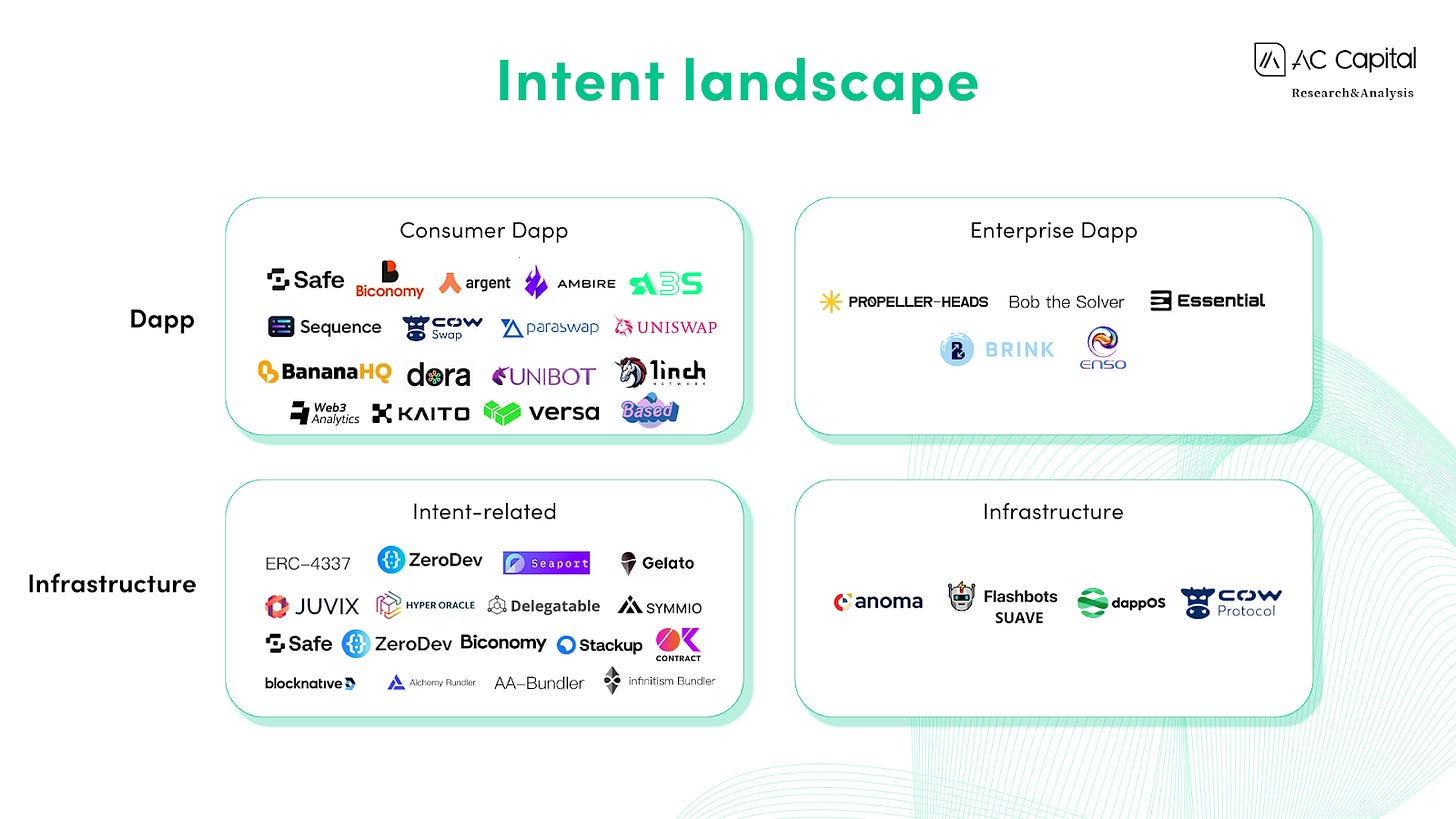
Infrastructure: (Intent-Centric Intent Architecture)
DappOS: The first intent-centric Web3 operating protocol that builds an intermediate layer between users and cryptographic infrastructure such as public chains and cross-chain bridges, enabling Web3 users to seamlessly interact with products without awareness. Recently, DappOS released Version 2;
Flash 2.0 SUAVE: SUAVE is an independent plug-and-play modular MEV full-chain ordering layer. Preferences (a core concept of SUAVE) is similar to the Intent concept, both providing a way for ordinary users to customize transactions and ultimately assisting users in achieving optimal execution. Flashbots plans to launch SUAVE Centauri in Q4 2023;
Anoma: Intent-centric universal Dapp architecture that can be modularly deployed to L1, L1.5, and L2. It can be embedded in various EVM frameworks as modular components for invocation. The latest development in the Anoma ecosystem is Anoma Privacy Settlement Layer 1 - Namada is about to exit the v 0.22.0 testnet;
Cow Protocol: CoW Protocol builds a settlement network for traders and interpreters and released the new Intent system, Cow Hooks, in July for custom DeFi operations. In August, CoW Protocol processed a total transaction volume of 1.05 B and generated a profit of 5.3 M.
Supporting Facilities: (Supporting infrastructure related to Intent and account abstraction wallets)
ERC 4337: ERC 4337's User Operation is the user's intent, including paying gas tokens, payment selection, login method, replacing the current transaction memory pool, thereby achieving account abstraction and improving wallet interaction experience.
Supporting facilities related to account abstraction: bundler infrastructure (StackUp, Blocknative, Alchemy Bundler, AA-Bundler, infinitism Bundler), wallet SDK (Safe, ZeroDev, Biconomy);
Supporting facilities related to intent: Juvix (intent-based programming language), Seaport (open-source NFT trading protocol) Gelato (Web3 automation service provider for smart contracts), okcontract (low-level intent automation tool), Delegatable (smart contract authorization proxy tool), Hyper Oracle (off-chain automation service), symmio (intent-based on-chain derivative trading framework).
Enterprise applications: (integration of intent infrastructure for Dapps, API, modular intent layer, domain-specific parsers)
Transaction Parser API: PropelleHeads;
Intent API: EnsoFinance;
Intent trading infrastructure: Bob the Solver, Brink;
Composable intent tools: Essential.
Consumer applications: (user interactive smart interfaces such as Wallets, Dex, Web3 AI Agents, smart search engines)
Wallets: Safe, Bitconomy, Argent, Ambire, Sequence, Versa, A 3 SProtocol;
Dex: CowSwap, Paraswap, Uniswap, 1inch, BananaHq, basedmarkets;
Smart frontends: Unibot, Dora, Web3 Analytics, kaito.ai.
Based on intent architecture, supporting facilities, and enterprise application (due to space limitations, only listed here without elaboration), attempting to solve the underlying problems of intent-based implementation, but infrastructure cannot be achieved in one fell swoop. The trend of intent consumer application layer is the really exciting part, where the potential of intelligent interaction is demonstrated through the evolution of wallet, Dex, and other interaction entry points. Wallet intelligence: ERC-4337 introduces a new UserOps layer where users express their intentions, and the bundler converts these intentions into executable signed transactions. In recent months, the number of ERC-4337 users has increased significantly, and the motivation of ZeroDev, Biconomy, and Safe modular smart accounts is driving the emergence of AA + intent. AA + intent has the potential to stimulate the arrival of Wallet Intelligence (SCW) in the future.
DEX architecture transformation: Intent-based trading aims to improve capital efficiency and user interaction experience. CoW Hooks connects complex actions such as trading, bridging, staking, and depositing. UniswapX already allows users to sign off-chain matching with on-chain settlement. Similar intent-based DEXs like BananaHq, Brink, basedmarkets, are gradually increasing, and the new intent-based RFQ narrative (SYMMIO) is unfolding. With more and more DEXs and aggregators transitioning to intent-based architecture, the DEX landscape is undergoing tremendous changes.
Source: https://twitter.com/BananaHQio/status/1694013407929020740
Smartization of interactive entrance: similar to the transformation of the web3 front-end interactive interface by TG Bot, the interactive entrance focuses on understanding the user's intent and systematically converting it into automated, actionable tasks. Not only TG Bot-like trading robots, but also web3 AI agents and web3 intelligent search engines are making web3 interactions more intelligent.
Source: https://twitter.com/awasunyin/status/169540582237605496
Challenges and prospects of smartization of web3 interactions
In the past, the interactive experience of web3 products has hindered widespread adoption, and the wealth creation effect on the chain has overshadowed many product issues; now, liquidity and user attention are fragmented, and on-chain liquidity is scarce.
At the ETHCC conference in July, developers extensively discussed the future of intent-centric and how to help users complete DAPP interactions in a more intelligent way in web3. However, intent-centric still faces many challenges in landing application:
Lack of intent-related programming languages (similar to Juvix)
Lack of suitable intent architecture (similar to Anoma)
Lack of domain-specific solvers (similar to Bob The Solver)
Centralized and closed intent implementation (similar to CowSwap)
Lack of front-end intent recognition parsers (similar to Unibot)
Lack of composable intent implementation (similar to Brink)
Intent security risks (mentioned in Paradigm article)
There are challenges and hopes. With the emergence of intent-centric protocols, Web3 has the potential to evolve into a more user-friendly smart interactive interface. Users can interact with mainstream applications such as Uniswap, Blur, and AAVE in a one-stop manner. The interaction is as simple as taking an Uber ride. This is the real opportunity for Web3 Dapps to surpass Web2 in terms of user experience. What's more, by combining Anoma, Flashbots SUAVE, and DappOS, we can imagine a more intelligent, customizable, and fair intent-centric Web3 on-chain interaction. With intent at the center, the power of discourse is put back into the hands of users. Even regular users can empower third-party robots/parsers to facilitate customized transactions (transaction fees, slippage, privacy, cross-chain, MEV, or other intents). In the future, users will no longer be passive participants on the chain, nor will they be exploited by MEV Searchers and Validators. They will become the true helmsmen of on-chain activities. Looking forward to the intelligent future of Web3 interactions, be it account abstraction, chain abstraction, or intent, Web3 is finally concerned about user experience. The dawn of intelligent interaction is about to illuminate the dark forest.
Acknowledgements
Many thanks to Web3 Analytics, Crypto V, Haotian, Chenjian Jason, Luke, Grace Deng, SixSix.eth, POOR DAO, #017, armonio.eth, and Kiwibig.eth for their valuable discussions, opinions, and feedback on this article.
References
https://twitter.com/mindaoyang/status/1696819223073571016
https://twitter.com/Delphi_Digital/status/1696626118164652295
https://twitter.com/awasunyin/status/169540582237605496
https://twitter.com/0xren_cf/status/1664320654819180564
https://twitter.com/LukeWasm/status/1691434740635873280
https://twitter.com/DodoResearch/status/1694652157830836640
https://ethglobal.com/showcase/bob-the-solver-yxtgp
https://www.youtube.com/watch?v=mdYwfW6tMJ8&t=85s
https://www.youtube.com/watch?v=G0nFyq9DDPw
https://www.youtube.com/watch?v=NMqaCGxSRQY
https://www.youtube.com/watch?v=DIvHVvjwhAs&t=22s
https://medium.com/banana-sdk/intent-is-all-you-need-part-1-1c5c11ee3b6f
https://medium.com/alliancedao/intents-are-just-7deaeb4336be
https://mirror.xyz/sevenxventures.eth/ fknoBf 3 zOoBf 55 zNFBpMQAIat 6 iCT 9 tvrN 2 AY 1 j 4 S v4
https://dba.mirror.xyz/NTg 5 FS q1o_YiL_KJrKBOsOkyeiNUPobvZUrLBGceagg
https://www.propellerheads.xyz/blog/intents-and-where-to-find-them
https://www.propellerheads.xyz/blog/blockchain-and-llms
https://www.paradigm.xyz/2023/06/intents
https://www.nngroup.com/articles/ai-paradigm/
https://aigc.phodal.com/llm-arch-user-intent-oriented-design.html
https://gracedeng.substack.com/p/decoding-intents-revolutionizing
https://thedefisaint.substack.com/p/intent-centric-a-narrative-worth
https://writings.fetcch.xyz/how-to-think-about-cross-chain-cowswap
https://www.brink.trade/blog/powerful-intents-part-1
https://blog.essential.builders/introducing-essential/
https://www.propellerheads.xyz/blog/intents-and-where-to-find-them
https://writings.flashbots.net/the-future-of-mev-is-suave/
https://www.blocknative.com/blog/ethcc-understanding-4337
https://writings.flashbots.net/mevm-suave-centauri-and-beyond
https://ethresear.ch/t/how-can-we-decentralize-intents/16456
https://www.gartner.com/en/documents/3599617










